Construction Project Management: An Overview
Introduction
Imagine you’re conducting a symphony, where every note and movement must come together perfectly from the first rehearsal to the final performance. Managing a construction project is similar — it involves carefully planning, directing, and organizing every phase, from the initial idea to the finished building. The goal is to complete the project on time, within budget, and to the highest standards.

The Role of a Construction Project Manager
A construction project manager (CPM) is akin to the conductor of an orchestra, working closely with architects, owners, and contractors to ensure everyone is on the same page. The key responsibilities of a CPM include:
- Planning: Creating detailed plans to organize each step of the
project.
Hiring and Supervising: Hiring the right team, letting go of underperformers, and supervising everyone. - Setting Goals: Establishing clear, achievable goals to guide the
project.
Delivering on Time: Ensuring the project stays on schedule. - Staying on Budget: Managing the budget to prevent
overspending.
Communication: Regularly updating the client and stakeholders on progress. - Dispute Management: Resolving conflicts and disputes fairly.
- Contract Drafting: Creating clear, legally binding agreements with contractors and suppliers.
- Risk Management: Identifying potential problems and planning solutions in advance.
Skills Required for a Construction Project Manager
To excel as a CPM, you need a combination of technical and interpersonal skills:
- Technical Communication: Strong verbal, written, and presentation skills to ensure smooth communication and avoid misunderstandings.
- Building Code Knowledge: Understanding zoning laws, fire protection, and structural standards.
- Construction Estimating: Accurately forecasting materials and costs.
- Project Control and Scheduling: Planning, controlling costs, scheduling resources, and managing changes.
- Team Management: Coordinating multiple teams and fostering a positive work environment.
- Leadership: Inspiring and motivating the team towards a common
goal.
Qualifications for a Construction Project Manager
Qualification Required for a Construction Project Manager
A solid educational background and relevant experience are crucial. Preferred qualifications include:
- Bachelor’s Degree: In Engineering, Architecture, Project Management, Construction Management, Civil Engineering, or a related field.
- Proficiency in CAD Software: Such as Sketchup, AutoCAD, SolidWorks, Revit.
- Project Management Experience: Especially in managing engineering or design projects from inception to completion.
The Project Lifecycle in Construction
The construction project lifecycle consists of five key phases:
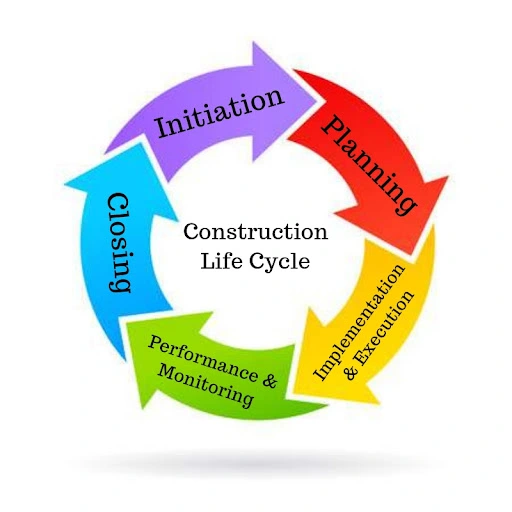
- Project Initiation and Conception: The journey begins with an idea, feasibility tests, and assembling a dedicated team.
- Project Planning and Definition: Defining the project, setting timelines, and outlining the budget.
- Project Execution and Launch: Bringing the plan to life with regular progress reports.
- Project Performance: Monitoring performance to ensure the project stays on track and within budget.
- Project Close: Finalizing all aspects and presenting the completed project to the client for approval.
Key Phases of Construction Projects with key activities and challenges
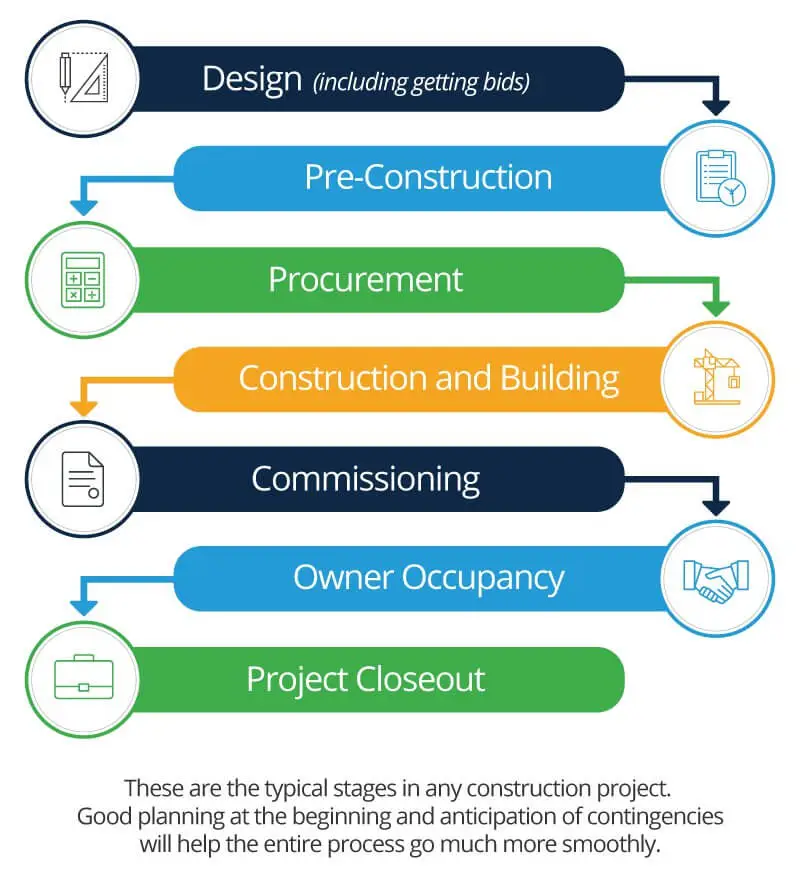
- Pre-Design (Project Initiation): Evaluating the project’s
requirements and feasibility.
Key Activities: Feasibility study, project initiation document (PID), and construction documents.
Challenges: Achieving difficult objectives, drafting precise contracts, and clear communication on budgets and goals. - Design (Pre-Construction): Creating comprehensive plans and
preparing for construction.
Key Activities: Choosing contractors, establishing a chain of command, cost estimation, risk assessment, and documentation.
Challenges: Communication breakdowns, legal conflicts, and environmental concerns. - Procurement: Sourcing, purchasing, and transporting materials,
equipment, and services.
Key Activities: Sourcing materials and building the team.
Challenges: Deciding between local and global sourcing, market volatility, and clear contractual agreements. - Construction and Monitoring: Physical construction begins, with
daily tasks performed by contractors.
Key Activities: Building the structure and maintaining documentation.
Challenges: Coordinating schedules, maintaining safety protocols, and addressing unexpected issues. - Post-Construction (Closeout): Wrapping up the project and handing
it over to the client.
Key Activities: Reviewing with the client, finalizing documents, and transferring ownership.
Challenges: Addressing client feedback, handling legal disputes, and finalizing documentation efficiently.
Construction Project Planning and Scheduling
Effective planning and scheduling are crucial for the success of construction projects. Key tools and methods include:
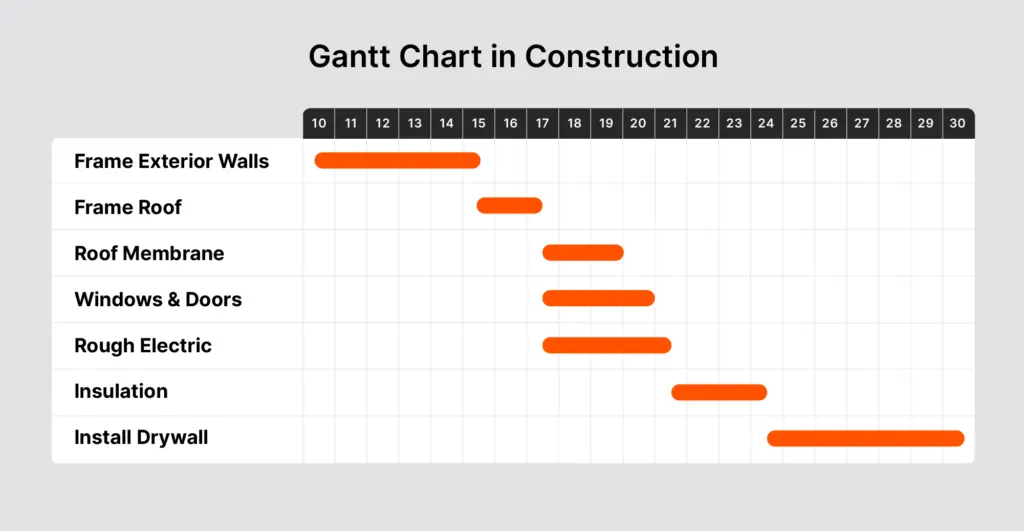
Gantt Chart: A visual representation of tasks and timelines, showing start and end dates, task duration, and overlaps.
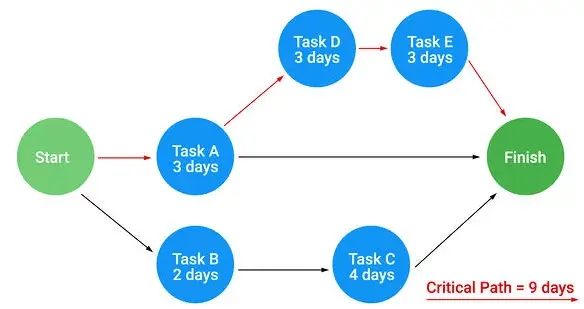
Critical Path Method (CPM):Identifies essential tasks and scheduling flexibilities. The critical path is the longest sequence of tasks that must be completed on time for the entire project to finish on schedule.
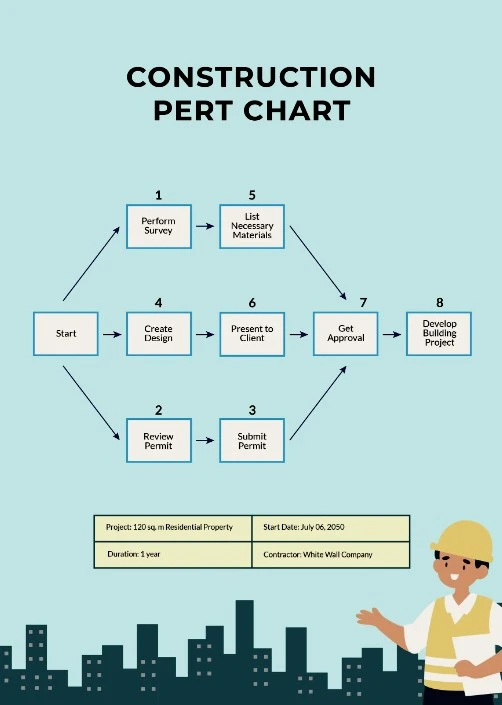
Project Evaluation Review Technique (PERT): Estimates the time needed to complete tasks and ensures efficient scheduling and coordination, incorporating optimistic, pessimistic, most likely, and expected time estimates.
Resource Allocation in Construction Projects
Effective resource allocation involves managing materials, labor, and equipment:
- Materials Management: Predicting needs, scheduling deliveries, and tracking inventory.
- Labor Management: Assigning tasks, scheduling shifts, and controlling labor costs.
- Equipment Management: Scheduling equipment use, maintaining equipment, and deciding whether to rent or buy.
Time Management in Construction Projects
Key strategies for effective time management include:
- Scheduling: Creating detailed project schedules using tools like Gantt charts, CPM, and PERT.
- Monitoring Progress: Regular site inspections, meetings, and using project management software.
- Adjusting Plans: Being flexible and making adjustments as needed.
- Communication: Maintaining clear communication with all stakeholders.
Construction Budgeting and Cost Management
Construction budgeting involves estimating and allocating financial resources to ensure the project stays within budget. Key components include:
- Direct Costs: Construction materials, labor, equipment.
- Indirect Costs: Permits, consultant fees, overhead costs.
- Contingency Budgets: Funds set aside for unexpected costs.
Risk Management in Construction Projects
Effective risk management involves identifying, analyzing, and mitigating risks.
- Identifying Risks: Using methods like brainstorming, expert interviews, and historical data analysis.
- Risk Analysis: Evaluating the likelihood and impact of risks.
- Risk Mitigation: Developing strategies to minimize the impact of risks.
Consturction Quality Management
Quality management ensures that the project meets the required standards.
- Quality Planning: Setting clear quality objectives and standards.
- Quality Assurance: Implementing processes to ensure standards are met.
- Quality Control: Monitoring specific project outcomes to ensure compliance with standards.
Construction Safety Management
- Safety Protocols: Establishing and following strict safety protocols.
- Training and Awareness: Regular training sessions and safety briefings.
- Incident Response: Clear procedures for responding to accidents and emergencies.
Construction Communication
Effective communication ensures collaboration among all stakeholders.
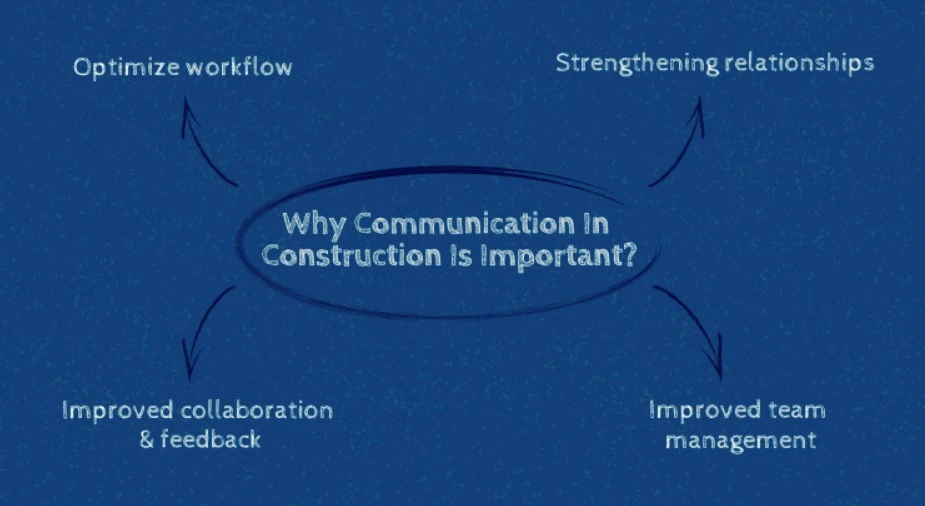
- Clear Channels: Establishing communication protocols early on.
- Investing in Technology: Using collaboration software for effective document management.
- Regular Meetings: Reviewing project status and aligning on goals.
- Documenting Everything: Keeping detailed records to avoid misunderstandings.
- Using a Single Data Source: Maintaining accurate records on a unified platform.
Construction Procurement Management
Construction procurement involves securing products and services needed to complete a project.
- Defining Project Requirements: Soliciting bids, purchasing supplies, monitoring contracts, and resolving issues.
- Benefits of Procurement: Ensuring high-quality materials and services are available when needed.
- Role of Procurement Managers: Handling logistics, bidding, purchases, schedules, and budgets.
- Types of Procurement: Design-bid-build, design and build, management contract, construction management, private finance, and emerging ideas.
Technological Integration in Construction Project Management

Emerging technologies are revolutionizing construction project management and taking it to next level.
- Building Information Modeling (BIM): A digital representation of the physical and functional characteristics of a building. It allows increased collaboration, reduced construction time and cost, improved quality and safety, enhanced sustainability, and better facility management.
- Project Management Software: Flexible and capable tools for managing tasks, collaborating, and maintaining project visibility.
- Construction Management Tools: TaskTag, Trello, Asana, ClickUp, Wrike, ActiveCollab, Airtable, Jira, and Height.
- Artificial Intelligence (AI): Enhancing planning, error reduction, resource optimization, and real-time monitoring. Learn more about how AI is shaping the future of Construction Project Management
- Internet of Things (IoT): Using sensors and devices to collect and exchange data, improving safety, efficiency, and quality.
- Virtual Reality (VR) and Augmented Reality (AR): Creating immersive environments for design visualization, safety training, on-site support, and remote collaboration.
Sustainability in Construction

- Green Building: Using sustainable materials, efficient energy systems, and green features to reduce environmental impact. Impacts of Green Building are lower utility costs, reduced waste, improved indoor environmental quality, and enhanced occupant comfort.
- Energy Efficiency: Implementing strategies to reduce costs and
minimize environmental impact.
Strategies: Comprehensive energy management plans, replacing outdated equipment, automated lighting systems, natural light utilization, renewable energy sources, passive cooling techniques, and effective insulation. - Construction Waste Management: Reducing, reusing, and recycling
materials to minimize environmental impact.
Key Strategies: Source reduction, diverting and reusing materials, and recycling.
Conclusion
Construction project management is a multifaceted discipline that requires a blend of technical knowledge, leadership skills, and effective communication. By understanding the roles, responsibilities, and key phases of construction projects, and by leveraging emerging technologies and sustainable practices, construction project managers can successfully navigate the complexities of their projects. This comprehensive guide aims to equip you with the knowledge and tools needed to elevate your construction projects to new heights.





